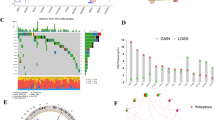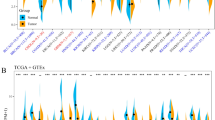Abstract
Purpose
Esophageal cancer (EC) is one of the most lethal gastrointestinal malignancies. Immunotherapy is a promising treatment modality for this disease. However, broader implementation of EC immunotherapy has been discouraged because of insufficient understanding of tumor interactions with the immune system. As with other malignancies, the current research on EC focuses on deciphering the immune cell signatures within the tumor microenvironment. However, the disease-elicited immune cell profiles in the paratumoral compartments are largely unknown.
Methods
We examined the immune cell signatures in 62 tissue samples from 16 EC patients in different esophageal tissue compartments: tumor tissue, peritumoral tissue, healthy esophageal tissue, and adjacent lymph nodes. We analyzed the proportions and distribution patterns of NK cells and CD4+ and CD8+ T cells as well as their death receptor (FasR, FasR/DR3)-expressing subpopulations. The analyzed data were then compared and correlated with the patients' clinicopathological data.
Results
We found that the FasR+ NK cells, CD4+ and CD8+ T cells infiltrated lymph nodes at the lowest levels and that the FasR+DR3+ CD4+ T cells were enhanced in tumors. The comparisons with the clinicopathological data revealed a major impact of active smoking on the reduction in paratumoral NK cells and the upregulation of FasR in tumor-infiltrating NK and CD8+ T cells. The lymph node metastatic stage, tumor stage, and Mandard grade correlated with the compartmental proportions of the evaluated immune cells.
Conclusion
The novel association of the disease state with tumoral and paratumoral immune cell signatures suggests new possibilities for personalized immunotherapy for EC patients.





Similar content being viewed by others
References
Al-Zoughbi W, Hoefler G (2019) Tumor macroenvironment: an update. Pathobiology. https://doi.org/10.1159/000502097
Al-Zoughbi W, Huang J, Paramasivan GS, Till H, Pichler M, Guertl-Lackner B, Hoefler G (2014) Tumor macroenvironment and metabolism. Semin Oncol 41:281–295. https://doi.org/10.1053/j.seminoncol.2014.02.005
Badalamenti G et al (2019) Role of tumor-infiltrating lymphocytes in patients with solid tumors: can a drop dig a stone? Cell Immunol 343:103753. https://doi.org/10.1016/j.cellimm.2018.01.013
Behr DS et al (2014) Prognostic value of immune cell infiltration, tertiary lymphoid structures and PD-L1 expression in Merkel cell carcinomas. Int J Clin Exp Pathol 7:7610–7621
Bijl M, Horst G, Limburg PC, Kallenberg CG (2001) Effects of smoking on activation markers, Fas expression and apoptosis of peripheral blood lymphocytes. Eur J Clin Invest 31:550–553. https://doi.org/10.1046/j.1365-2362.2001.00842.x
Chen K et al (2017) Tumor-infiltrating CD4+ lymphocytes predict a favorable survival in patients with operable esophageal squamous cell carcinoma. Med Sci Monit 23:4619–4632. https://doi.org/10.12659/msm.904154
de Ruiter EJ, Ooft ML, Devriese LA, Willems SM (2017) The prognostic role of tumor infiltrating T-lymphocytes in squamous cell carcinoma of the head and neck: a systematic review and meta-analysis. Oncoimmunology 6:e1356148. https://doi.org/10.1080/2162402X.2017.1356148
Emens LA, Middleton G (2015) The interplay of immunotherapy and chemotherapy: harnessing potential synergies. Cancer Immunol Res 3:436–443. https://doi.org/10.1158/2326-6066.CIR-15-0064
Fridman WH, Galon J, Pages F, Tartour E, Sautes-Fridman C, Kroemer G (2011) Prognostic and predictive impact of intra- and peritumoral immune infiltrates. Cancer Res 71:5601–5605. https://doi.org/10.1158/0008-5472.CAN-11-1316
Fridman WH, Zitvogel L, Sautes-Fridman C, Kroemer G (2017) The immune contexture in cancer prognosis and treatment. Nat Rev Clin Oncol 14:717–734. https://doi.org/10.1038/nrclinonc.2017.101
Fu Q et al (2019) Prognostic value of tumor-infiltrating lymphocytes in melanoma: a systematic review and meta-analysis. Oncoimmunology 8:1593806. https://doi.org/10.1080/2162402X.2019.1593806
Ge Z, Sanders AJ, Ye L, Jiang WG (2011) Aberrant expression and function of death receptor-3 and death decoy receptor-3 in human cancer. Exp Ther Med 2:167–172. https://doi.org/10.3892/etm.2011.206
Giraldo NA et al (2015) Orchestration and prognostic significance of immune checkpoints in the microenvironment of primary and metastatic renal cell cancer. Clin Cancer Res 21:3031–3040. https://doi.org/10.1158/1078-0432.CCR-14-2926
Hendry S et al (2017) Assessing tumor-infiltrating lymphocytes in solid tumors: a practical review for pathologists and proposal for a standardized method from the international immuno-oncology biomarkers working group: part 2: TILs in melanoma gastrointestinal tract carcinomas, non-small cell lung carcinoma and mesothelioma, endometrial and ovarian carcinomas, squamous cell carcinoma of the head and neck, genitourinary carcinomas, and primary brain tumors. Adv Anat Pathol 24:311–335. https://doi.org/10.1097/PAP.0000000000000161
Janssen LME, Ramsay EE, Logsdon CD, Overwijk WW (2017) The immune system in cancer metastasis: friend or foe? J Immunother Cancer 5:79. https://doi.org/10.1186/s40425-017-0283-9
Koury J et al (2018) Immunotherapies: exploiting the immune system for cancer treatment. J Immunol Res 2018:9585614. https://doi.org/10.1155/2018/9585614
Kumar R, Herbert PE, Warrens AN (2005) An introduction to death receptors in apoptosis. Int J Surg 3:268–277. https://doi.org/10.1016/j.ijsu.2005.05.002
Lee JY et al (2015) Association between chemotherapy-response assays and subsets of tumor-infiltrating lymphocytes in gastric cancer: a pilot study. J Gastric Cancer 15:223–230. https://doi.org/10.5230/jgc.2015.15.4.223
Lee H et al (2019) Integrated molecular and immunophenotypic analysis of NK cells in anti-PD-1 treated metastatic melanoma patients. Oncoimmunology 8:e1537581. https://doi.org/10.1080/2162402X.2018.1537581
Miksch RC et al (2019) Prognostic impact of tumor-infiltrating lymphocytes and neutrophils on survival of patients with upfront resection of pancreatic cancer. Cancers. https://doi.org/10.3390/cancers11010039
Moch H, Cubilla AL, Humphrey PA, Reuter VE, Ulbright TM (2016) The 2016 WHO classification of tumours of the urinary system and male genital organs—part A: renal penile, and testicular tumours. Eur Urol 70:93–105. https://doi.org/10.1016/j.eururo.2016.02.029
Moujaess E, Haddad FG, Eid R, Kourie HR (2019) The emerging use of immune checkpoint blockade in the adjuvant setting for solid tumors: a review. Immunotherapy. https://doi.org/10.2217/imt-2019-0087
Napier KJ, Scheerer M, Misra S (2014) Esophageal cancer: a review of epidemiology, pathogenesis, staging workup and treatment modalities. World J Gastrointest Oncol 6:112–120. https://doi.org/10.4251/wjgo.v6.i5.112
O'Connell J (2002) Fas ligand and the fate of antitumour cytotoxic T lymphocytes. Immunology 105:263–266. https://doi.org/10.1046/j.1365-2567.2002.01379.x
Park CK, Kim SK (2017) Clinicopathological significance of intratumoral and peritumoral lymphocytes and lymphocyte score based on the histologic subtypes of cutaneous melanoma. Oncotarget 8:14759–14769. https://doi.org/10.18632/oncotarget.14736
Park MH, Song MJ, Cho MC, Moon DC, Yoon DY, Han SB, Hong JT (2012) Interleukin-32 enhances cytotoxic effect of natural killer cells to cancer cells via activation of death receptor 3. Immunology 135:63–72. https://doi.org/10.1111/j.1365-2567.2011.03513.x
Pelekanou V et al (2017) Effect of neoadjuvant chemotherapy on tumor-infiltrating lymphocytes and PD-L1 expression in breast cancer and its clinical significance. Breast Cancer Res 19:91. https://doi.org/10.1186/s13058-017-0884-8
Peter ME, Hadji A, Murmann AE, Brockway S, Putzbach W, Pattanayak A, Ceppi P (2015) The role of CD95 and CD95 ligand in cancer. Cell Death Differ 22:549–559. https://doi.org/10.1038/cdd.2015.3
Rice TW, Patil DT, Blackstone EH (2017) 8th edition AJCC/UICC staging of cancers of the esophagus and esophagogastric junction: application to clinical practice. Ann Cardiothorac Surg 6:119–130. https://doi.org/10.21037/acs.2017.03.14
Sharma P, Hu-Lieskovan S, Wargo JA, Ribas A (2017) Primary, adaptive, and acquired resistance to cancer immunotherapy. Cell 168:707–723. https://doi.org/10.1016/j.cell.2017.01.017
Short MW, Burgers KG, Fry VT (2017) Esophageal cancer. Am Fam Physician 95:22–28
Sorbye SW et al (2012) Prognostic impact of peritumoral lymphocyte infiltration in soft tissue sarcomas. BMC Clin Pathol 12:5. https://doi.org/10.1186/1472-6890-12-5
Steele KE et al (2018) Measuring multiple parameters of CD8+ tumor-infiltrating lymphocytes in human cancers by image analysis. J Immunother Cancer 6:20. https://doi.org/10.1186/s40425-018-0326-x
Strizova Z et al (2019) NK and T cells with a cytotoxic/migratory phenotype accumulate in peritumoral tissue of patients with clear cell renal carcinoma. Urol Oncol 37:503–509. https://doi.org/10.1016/j.urolonc.2019.03.014
Sudo T et al (2017) Clinical impact of tumor-infiltrating lymphocytes in esophageal squamous cell carcinoma. Ann Surg Oncol 24:3763–3770. https://doi.org/10.1245/s10434-017-5796-4
Sun T, Miao X, Zhang X, Tan W, Xiong P, Lin D (2004) Polymorphisms of death pathway genes FAS and FASL in esophageal squamous-cell carcinoma. J Natl Cancer Inst 96:1030–1036. https://doi.org/10.1093/jnci/djh187
Tamura R, Ohara K, Sasaki H, Morimoto Y, Kosugi K, Yoshida K, Toda M (2018) Difference in immunosuppressive cells between peritumoral area and tumor core in glioblastoma. World Neurosurg 120:e601–e610. https://doi.org/10.1016/j.wneu.2018.08.133
Thies S, Langer R (2013) Tumor regression grading of gastrointestinal carcinomas after neoadjuvant treatment. Front Oncol 3:262. https://doi.org/10.3389/fonc.2013.00262
Wang Z et al (2017) Infiltrating CD4/CD8 high T cells shows good prognostic impact in pancreatic cancer. Int J Clin Exp Pathol 10:8820–8828
Wang K, Shen T, Siegal GP, Wei S (2017) The CD4/CD8 ratio of tumor-infiltrating lymphocytes at the tumor-host interface has prognostic value in triple-negative breast cancer. Hum Pathol 69:110–117. https://doi.org/10.1016/j.humpath.2017.09.012
Xie J et al (2016) Expression of immune checkpoints in T cells of esophageal cancer patients. Oncotarget 7:63669–63678. https://doi.org/10.18632/oncotarget.11611
Yao W, He JC, Yang Y, Wang JM, Qian YW, Yang T, Ji L (2017) The prognostic value of tumor-infiltrating lymphocytes in hepatocellular carcinoma: a systematic review and meta-analysis. Sci Rep 7:7525. https://doi.org/10.1038/s41598-017-08128-1
Zancope E et al (2010) Differential infiltration of CD8+ and NK cells in lip and oral cavity squamous cell carcinoma. J Oral Pathol Med 39:162–167. https://doi.org/10.1111/j.1600-0714.2009.00792.x
Zhang H, Chen J (2018) Current status and future directions of cancer immunotherapy. J Cancer 9:1773–1781. https://doi.org/10.7150/jca.24577
Zhang X et al (2005) Functional polymorphisms in cell death pathway genes FAS and FASL contribute to risk of lung cancer. J Med Genet 42:479–484. https://doi.org/10.1136/jmg.2004.030106
Zheng X et al (2018) Prognostic role of tumor-infiltrating lymphocytes in esophagus cancer: a meta-analysis. Cell Physiol Biochem 45:720–732. https://doi.org/10.1159/000487164
Zhu J et al (2017) Resistance to cancer immunotherapy mediated by apoptosis of tumor-infiltrating lymphocytes. Nat Commun 8:1404. https://doi.org/10.1038/s41467-017-00784-1
Zhu J, Petit PF, Van den Eynde BJ (2019) Apoptosis of tumor-infiltrating T lymphocytes: a new immune checkpoint mechanism. Cancer Immunol Immunother 68:835–847. https://doi.org/10.1007/s00262-018-2269-y
Acknowledgements
We thank the clinical research staff, professional laboratory staff and technicians for their assistance and Michal Rataj for assistance with the flow cytometry experiments. We also thank Prof. Ilja Striz and Dr. Alasdair M. Gilfillan for their critical review of the manuscript.
Funding
Research in the authors’ laboratories was supported by funding from the Charles University—project GA UK No. 364218, PRIMUS/MED/12, by funding from the Ministry of Health, Czech Republic—project AZV 16-28135A and the conceptual development fund of research organization University Hospital Motol, Prague, Czech Republic 00064203.
Author information
Authors and Affiliations
Corresponding author
Ethics declarations
Conflict of interest
J. Bartunkova is a part-time employee and a minority shareholder of Sotio, a.s., a biotech company developing cell-based immunotherapy. Z. Strizova, M. Snajdauf, D. Stakheev, P. Taborska, J. Vachtenheim Jr, J. Biskup, R. Lischke, and D. Smrz declare no conflict of interest.
Ethical approval
This study was approved by the Ethics committee for multicentric studies and evaluation of the Faculty Hospital Motol, Prague, Czech Republic. All procedures performed in studies involving human participants were in accordance with the ethical standards of the institutional and/or national research committee and with the 1964 Helsinki Declaration and its later amendments or comparable ethical standards.
Informed consent
Informed consent was obtained from all individual participants included in the study.
Additional information
Publisher's Note
Springer Nature remains neutral with regard to jurisdictional claims in published maps and institutional affiliations.
Zuzana Strizova and Martin Snajdauf are co-first authors.
Electronic supplementary material
Below is the link to the electronic supplementary material.
Rights and permissions
About this article
Cite this article
Strizova, Z., Snajdauf, M., Stakheev, D. et al. The paratumoral immune cell signature reveals the potential for the implementation of immunotherapy in esophageal carcinoma patients. J Cancer Res Clin Oncol 146, 1979–1992 (2020). https://doi.org/10.1007/s00432-020-03258-y
Received:
Accepted:
Published:
Issue Date:
DOI: https://doi.org/10.1007/s00432-020-03258-y




